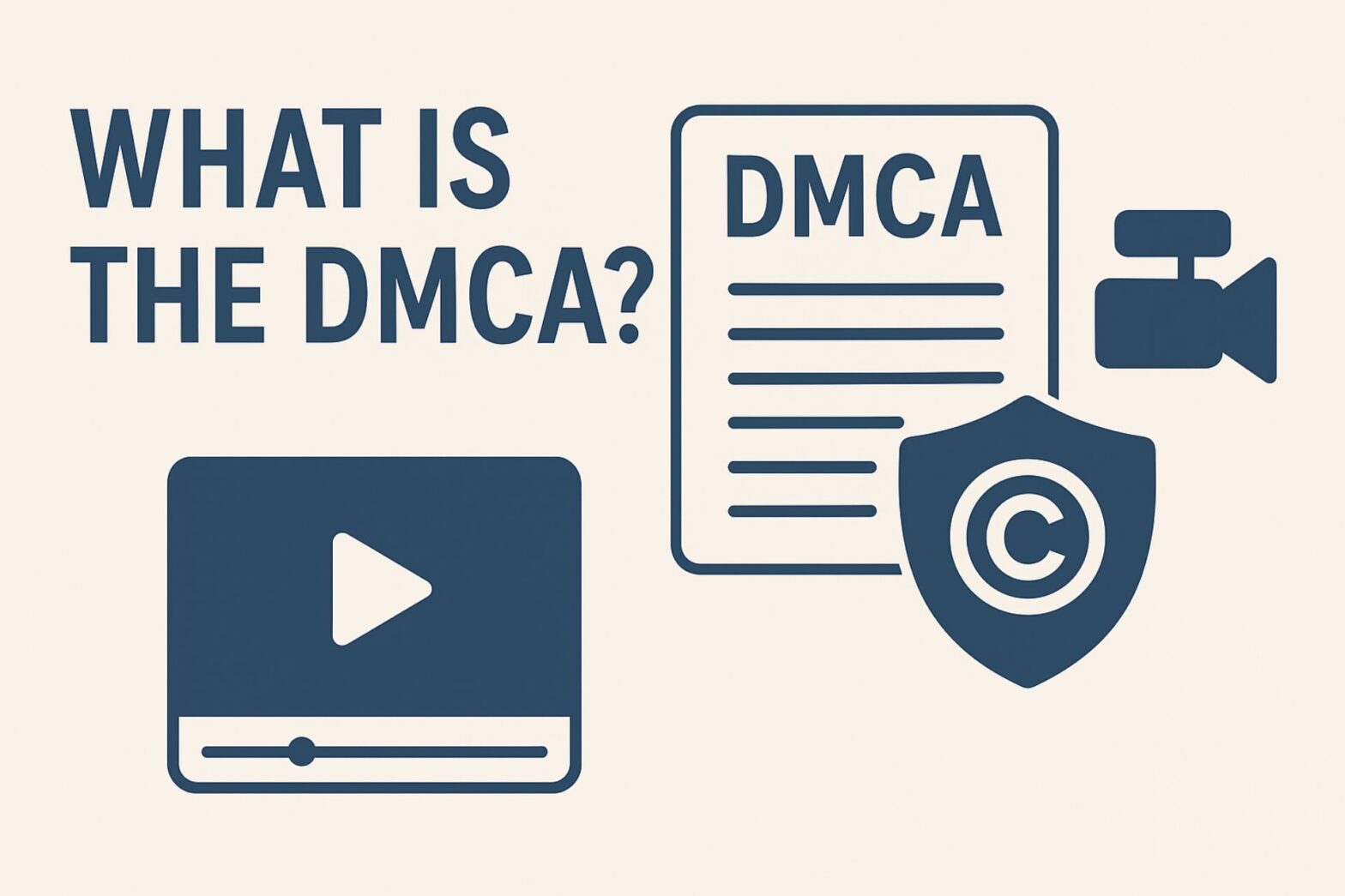Table of Contents
Video content is everywhere YouTube, Instagram Reels, TikTok, Twitch, and more. But along with the opportunities comes a growing challenge: DMCA copyright claims.
One wrong music track, a short movie clip, or even a few seconds of copyrighted footage can lead to takedowns, muted audio, lost revenue, or even channel termination. That’s why understanding the DMCA and knowing how to protect your videos is essential for every creator, marketer, and business.
What is the DMCA?
DMCA stands for the Digital Millennium Copyright Act, a U.S. copyright law passed in 1998. Its main purpose is to protect the rights of content owners in the digital space and to prevent unauthorized use of copyrighted material online.
While it’s an American law, it affects creators worldwide because major platforms like YouTube, Facebook, Instagram, and Twitch operate under DMCA rules.
Why it matters for you:
If you upload videos with copyrighted content (music, visuals, TV clips, etc.) without permission, the copyright owner can request your content be removed under the DMCA.
How Does the DMCA Work?
The DMCA operates through a notice-and-takedown process. Here’s how it works:
- DMCA Takedown Notice
A copyright holder (or their legal representative) files a formal request to a platform to remove infringing content. - Safe Harbor Provision
Platforms like YouTube are protected from lawsuits as long as they remove or disable access to infringing content quickly when notified. - Counter-Notification
If you believe the claim is wrong, you can file a counter-notice proving you own the rights or have permission to use the content. If the claimant doesn’t take legal action within 10–14 business days, your content may be restored.
DMCA Copyright Claims vs. Content ID Claims
It’s important to know the difference:
- Content ID Claim – Automated system (on YouTube) that scans videos for copyrighted material and either monetizes, blocks, or tracks the video. Often less severe.
- DMCA Claim – Manual legal request from a copyright holder. This can result in strikes, legal implications, and full video removal.
Example:
If you use a popular Bollywood song in your vlog:
- Content ID might just monetize your video for the music owner.
- A DMCA claim could take your video down completely.
Consequences of a DMCA Copyright Claim
The impact can be serious:
- Video Removal – Your content is taken offline.
- Monetization Loss – You lose ad revenue or sponsorship potential.
- Channel Strikes – Repeated violations can lead to suspension or permanent bans.
- Muted Audio – Parts of your video may be muted automatically.
- Legal Risk – In rare but serious cases, you could face lawsuits for damages.
Common Triggers for DMCA Claims on Videos
Creators often get hit for:
- Using copyrighted songs without a license.
- Uploading movie or TV show clips.
- Streaming sports events or concerts.
- Posting gameplay without following publisher guidelines.
- Reusing other creators’ videos without permission.
Even short clips (as little as 3–5 seconds) can trigger a claim.
How to Protect Your Videos from DMCA Claims
Use Copyright-Safe Music & Assets
This is the most effective way to avoid DMCA trouble. Use royalty-free music from trusted sources like:
- Hoopr Smash – Bollywood, indie, and regional music safe for commercial use.
- Public domain or Creative Commons licensed tracks (make sure you understand the license terms).
Get Proper Licenses
If you want to use a specific copyrighted song, footage, or image:
- Purchase a commercial license from the rights holder.
- Keep the license document in your records.
- If you receive a false claim, submit the license as proof.
Create Original Content
The safest way to avoid DMCA strikes is to make everything yourself:
- Film your own videos.
- Record your own audio.
- Create your own background music or hire a composer.
- Design your own graphics and animations.
Understand Fair Use (With Caution)
Fair use allows limited use of copyrighted material without permission for commentary, criticism, news reporting, parody, etc.
But it’s a gray area:
- Platforms may still take down your video even if you believe it’s fair use.
- Fair use is a legal defense, not a guarantee.
Example: Using 10 seconds of a movie clip for a film review may be fair use but the copyright owner can still challenge it.
Credit the Source (But Know It’s Not a License)
Many creators think giving credit (“Music by…”) protects them. It doesn’t. Credit alone is not permission. You still need the proper license or rights to use the material.
How to Respond to a Wrongful DMCA Claim
If you believe a claim against you is false:
- Review the Claim – Check if it’s a Content ID claim or an actual DMCA takedown.
- Gather Proof – Collect licenses, receipts, emails, or contracts proving you have rights.
- File a Counter-Notification – Submit it via the platform’s dispute process.
- Wait for Response – The claimant has a set time (usually 10–14 business days) to take legal action. If they don’t, your video may be restored.
Warning: Filing a false counter-notice can have legal consequences. Only dispute if you’re certain.
Extra Tips for Copyright Safety
- Keep a License Archive – Store all proof of ownership and permissions in a safe, organized way.
- Use YouTube’s Copyright Checking Tool – It scans your video before publishing to detect possible claims.
- Follow Platform Guidelines – Twitch, Instagram, and YouTube all have detailed rules for music and media use.
- Stay Updated – Copyright laws and platform policies can change.
Why Music Is the #1 Cause of DMCA Strikes
For video creators, music is the most common trigger for DMCA issues.
- Even a few seconds of a popular track can get your video muted or taken down.
- Many creators unknowingly use “royalty-free” tracks that are only free for personal use, not commercial use.
Pro Tip: Use platforms like Hoopr that provide legally safe tracks for social media, ads, and branded videos. This ensures your content remains free from copyright headaches.
Conclusion
The DMCA exists to protect creative work but if you’re not careful, it can work against you.
To avoid DMCA copyright claims:
- Always use music, images, and video clips you have rights to.
- Keep all license proof organized.
- Understand the difference between Content ID and DMCA strikes.
- When in doubt, create original content or source from copyright-safe platforms.
By taking these steps, you can focus on creating videos that entertain, inspire, and grow your audience without worrying about takedowns or legal trouble.
Stay creative. Stay safe. And always respect the work of other creators.

